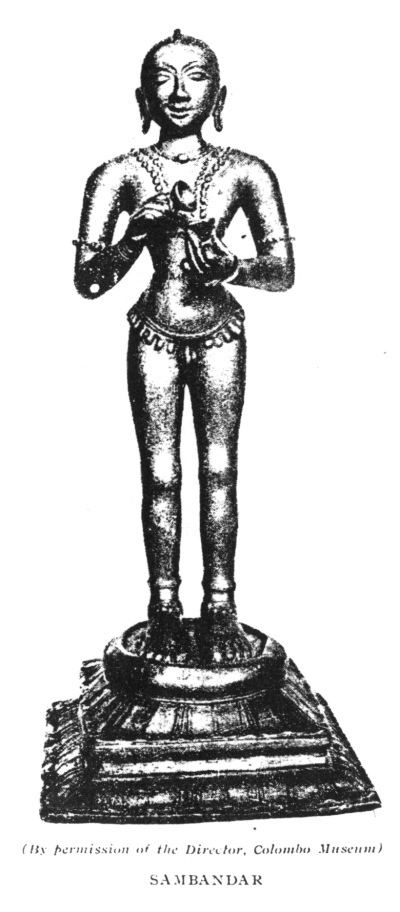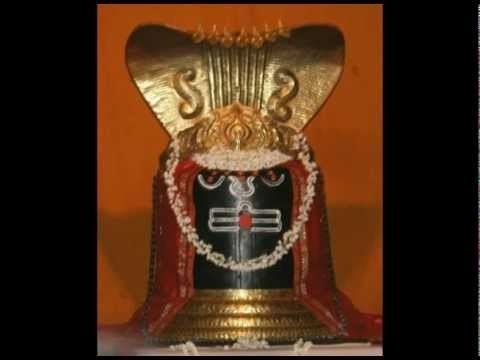Name Thirugyana Sambandar Died 660 AD Role Poet | Literary works Tevaram Philosophy Saivism Bhakti | |
Titles/honours Nayanar saint, Moovar | ||
Konjam thevaram konjam periya puranam thirugnana sambandar l sami thiagarajan l day 1
Sambandar (also called Thirugyana Sambandar, Tirugnana Sambanthar, Campantar, Champantar, Jnanasambandar, Gnanasambandar) was a young Saiva poet-saint of Tamil Nadu who lived around the 7th century CE.
Contents
- Konjam thevaram konjam periya puranam thirugnana sambandar l sami thiagarajan l day 1
- Sambandar mannil nalla kolli navaros
- Life
- Shrines
- Temples revered
- Tirumurai in worship services
- Review and analysis
- References

He is one of the most prominent of the sixty-three Nayanars, Tamil Saiva bhakti saints who lived between the sixth and the tenth centuries CE. Sambandar's hymns to Shiva were later collected to form the first three volumes of the Tirumurai, the religious canon of Tamil Saiva Siddhanta. He was a contemporary of Appar, another Saiva saint.

Sambandar mannil nalla kolli navaros
Life

Information about Sambandar comes mainly from the Periya Puranam, the eleventh-century Tamil book on the Nayanars that forms the last volume of the Tirumurai, along with the earlier Tiruttondartokai, poetry by Sundarar and Nambiyandar Nambi's Tiru Tondar Tiruvandadi. A Sanskrit hagiography called Brahmapureesa Charitam is now lost. The first volumes of the Tirumurai contain three hundred and eighty-four poems of Sambandar, all that survive out of a reputed more than 10,000 hymns.

According to the ancient texts, Sambandar was born to Sivapada Hrudiyar and his wife Bhagavathiar who lived in Sirkazhi in what is now Tamil Nadu. They were Saivite brahmins. When Sambandar was three years old his parents took him to the Shiva temple where Shiva and his consort Parvati appeared before the child. His father saw drops of milk on the child's mouth and asked who had fed him, whereupon the boy pointed to the sky and responded with the song Todudaya Seviyan, the first verse of the Tevaram. At his investiture with the sacred thread, at the age of seven, he is said to have expounded the Vedas with great clarity. Sambandar attained liberation (mukti) in "Visaka Nakshtara" in the Tamil month of "Visakam" at the age of sixteen soon after his marriage.
In the first half of the seventh century, apart from Saivism, Jainism and Buddhism were among the popular faiths in south India. The Pandyan King Koon Pandiyan had converted to Jainism, which Sambandar had long expressed opposition to. His queen Mangayarkkarasiyar invited Sambandhar after the king fell ill. According to a Saivite legend, Sambandar performed music for the king, which cured the king's disease. Later, Sambandar reconverted the king back to Shaivism. The legend goes on to state that with Sambandar's consent, the king impaled around 8000 Jains.
The ancient texts say that Samabandar brought two people back to life by singing hymns to them. One of those resurrected was the daughter of a business man, who offered her to Sambandar in marriage. He declined due to knowledge that he would soon die. At the age of 16, he is said to have attained salvation along with his bride during the marriage ceremony.
Shrines
An inscription of Rajaraja Chola I at Tiruvarur mentions Sambandar along with Appar, Sundarar and the latter's wife Nangai Paravaiyar.
Temples revered
Paadal Petra Sthalams are 275 temples that are revered in the verses of Tevaram and are amongst the greatest Shiva temples of the continent. Vaippu Sthalangal are places that were mentioned casually in the songs in Tevaram. The focus of the moovars (first three poets) hymns suggests darshan (seeing and being seen by God) within the puja (worship) offering. The hymnists made classificatory lists of places like katu (for forest), turai (port or refuge), kulam (water tank) and kalam (field) being used - thus both structured and unstructured places in the religious context find a mention in Tevaram.
Tirumurai in worship services
Tirumurai was one of the sole reasons for converting Vedic ritual to Agamic puja followed in Shiva temples. Though these two systems are overlapping, Agamic tradition ensures the perpetuation of the Vedic religion's emphasis on the efficacy of ritual as per Davis. Odhuvars, Sthanikars, or Kattalaiyars offer musical programmes in Shiva temples of Tamil Nadu by singing Tevaram after the daily rituals. These are usually carried out as chorus programme soon after the divine offering. There are records from Kulothunga Chola III from Nallanyanar temple in South Arcot indicating singing of Tiruvempavai and Tiruvalam of Manickavasagar during special occasion in the temple. During the times of cholas and previous pallavas the hymn reciters and musicians were known as uvacchar(chanters) and marars. It is noteworthy that these terms are also traceable in sangam period works.
Periya Puranam, the eleventh-century Tamil book on the Nayanars that forms the last volume of the Tirumurai primarily had references only to Tevaram and subsequently expanded to 12 parts and is one of the first anthologies of Tirumurai. One of the first anthologies of moovars hymns called the Tevara Arulmuraitirattu is linked to Tamil Saiva siddhantha philosophy by grouping ninety-nine verses into 10 categories. The category headings are God, soul, bond, grace,divine initiation, methodology, enlightenment, bliss, mantra and liberation - correspond to Umapthi's work, Tiruvarutpayan. Tirumurai kanda puranam is another anthology for Tirumurai as a whole, but primarily focuses on Tevaram. It is the first of the works to refer the collection of volumes as Tirumurai.
Review and analysis
There is strong dose of anti-Jain, anti-Buddhist and in general an anti-communal polemic in Tevaram poetry of Sambandar. This is only expected as we know from accounts as to how the saint was got incarnate out to destroy the excessive wickedness and duplicity perpetrated by rogue creeds. Sambandar is clear about his hatred for the evil and duplicity of the obscure communal creeds and the same opinion is expressed in the works of other divine incarnates of that period of both saiva and vaishnava pathways. According to Aiyangar, Manickavasagar's Tiruvackam partakes the characters of Tevaram hymners before him and express more intense form of devotion. Manikkavasagar, like Sundarar and Sambandar before him does not mince words while criticising the misinformation campaign of Sramana (Buddhist and Jain) communal creeds and in many places of Tiruvasagam calls them senseless, duplicitous, deceitful and falseful (poy samayattar). The fervor of utterances, the appeals to God by the Tamils do not find clear expression in other part of India.
In 1921, an English translation of Sambandhar's hymns was done by Francis Kingsbury and GE Phillips, both of United Theological College, Bangalore (Edited by Fred Goodwill) and published in a book as Hymns of the Tamil Śaivite Saints, by the Oxford University Press
